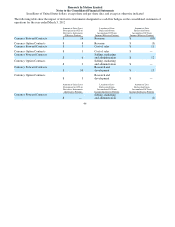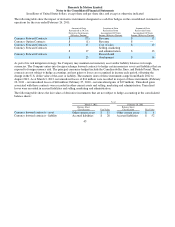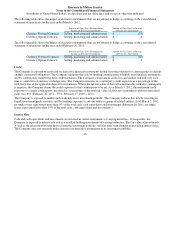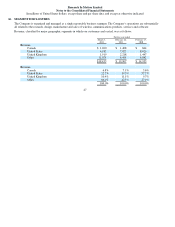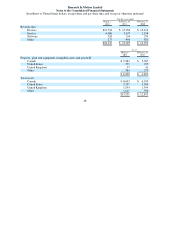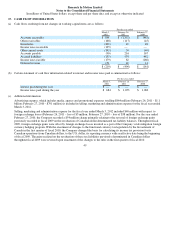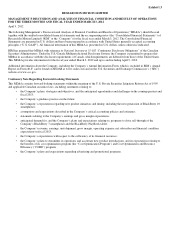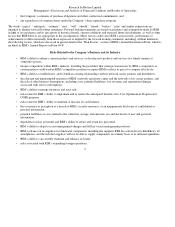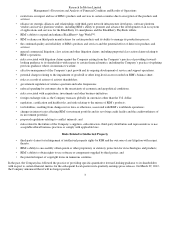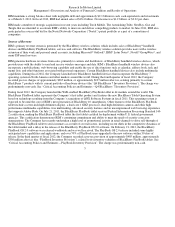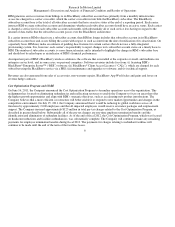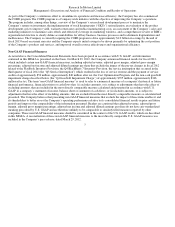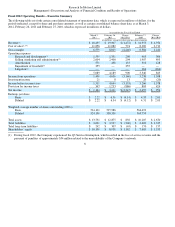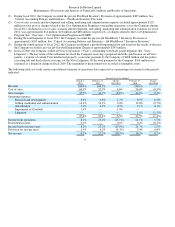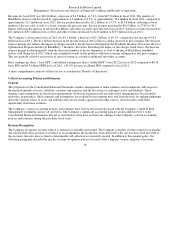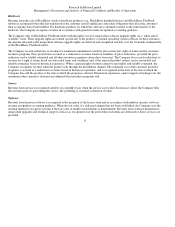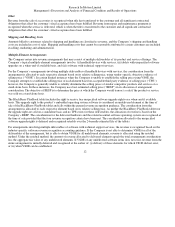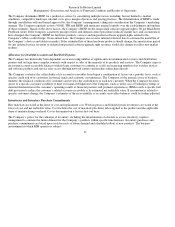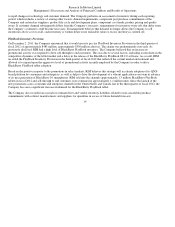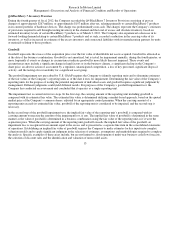Blackberry 2012 Annual Report Download - page 175
Download and view the complete annual report
Please find page 175 of the 2012 Blackberry annual report below. You can navigate through the pages in the report by either clicking on the pages listed below, or by using the keyword search tool below to find specific information within the annual report.
Research In Motion Limited
Management’s Discussion and Analysis of Financial Condition and Results of Operations
RIM maintains a strong balance sheet with negligible debt and approximately $2.1 billion in cash, cash equivalents and investments
as of March 3, 2012. In fiscal 2012, RIM had annual sales of $18.4 billion. Net income was $1.2 billion, or $2.22 per share.
RIM made a number of strategic acquisitions in recent years including Torch Mobile, The Astonishing Tribe, NewBay, Gist and
Tungle that are intended to accelerate RIM’s ability to innovate and deliver compelling products to market. In June 2011, RIM also
participated in a successful bid for the Nortel Networks Corporation (“Nortel”) patent portfolio as a part of a consortium of
companies.
Sources of Revenue
RIM’s primary revenue stream is generated by the BlackBerry wireless solution, which includes sales of BlackBerry handheld
devices and BlackBerry PlayBook tablets, services and software. The BlackBerry wireless solution provides users with a wireless
extension of their work and personal email accounts, including Microsoft Outlook , IBM Lotus Notes , Novell GroupWise , and
many ISP email services.
RIM generates hardware revenues from sales, primarily to carriers and distributors, of BlackBerry handheld wireless devices, which
provide users with the ability to send and receive wireless messages and data. RIM’s BlackBerry handheld wireless devices also
incorporate a mobile phone, web-browsing capability and enable the use of data functions such as calendar, address book, task and
memo lists, and other functions associated with personal organizers. Certain BlackBerry handheld devices also include multimedia
capabilities. During fiscal 2012, the Company launched new BlackBerry handheld devices that incorporate the BlackBerry 7
operating system in North America and other markets around the world. During the fourth quarter of fiscal 2012, the Company
recorded pre-tax charges of approximately $267 million, or approximately $197 million after-tax, relating primarily to certain
BlackBerry 7 products with its current portfolio of hardware devices (the “Q4 BlackBerry 7 Inventory Provision”). The charge was
predominantly non-cash. See “Critical Accounting Policies and Estimates – Q4 BlackBerry 7 Inventory Provision”.
During fiscal 2012, the Company launched the WiFi-enabled BlackBerry PlayBook tablet in 44 markets around the world. The
BlackBerry PlayBook tablet represents the Company’s first tablet product and features the new BlackBerry Tablet Operating System
based on technology resulting from the Company’s acquisition of QNX Software Systems in fiscal 2011. This operating system is
expected to become the core of RIM’s next generation of BlackBerry 10 smartphones. Other features of the BlackBerry PlayBook
tablet include a seven-inch high definition display, a dual core 1 GHZ processor, dual high definition cameras and other high
performance multimedia capabilities, true multitasking, advanced security features and an uncompromised web browsing experience
that supports Adobe Flash. On July 21, 2011, the BlackBerry PlayBook tablet received Federal Information Processing Standard 140-
2 certification, making the BlackBerry PlayBook tablet the first tablet certified for deployment within U.S. federal government
agencies. This certification demonstrates RIM’s continuing commitment and ability to meet the needs of security conscious
organizations. The Company has recently undertaken a high level of promotional activity in retail-channels to drive sell-through of
the BlackBerry PlayBook tablet to end customers as a result of several factors, including recent shifts in the competitive dynamics of
the tablet market and a delay in the release of the BlackBerry PlayBook OS 2.0 software. On February 21, 2012, the BlackBerry
PlayBook OS 2.0 software was released worldwide and was well-received. The PlayBook OS 2.0 release included some highly
anticipated new capabilities and applications, and over 70% of PlayBook users upgraded to the new software within 30 days of
release. In the third quarter of fiscal 2012, the Company recorded a pre-tax provision of approximately $485 million, approximately
$356 million after tax (the “PlayBook Inventory Provision”), related to its inventory valuation of BlackBerry PlayBook tablets. See
“Critical Accounting Policies and Estimates – PlayBook Inventory Provision”. The charge was predominantly non-cash.
5
®
®®® ®® ®


